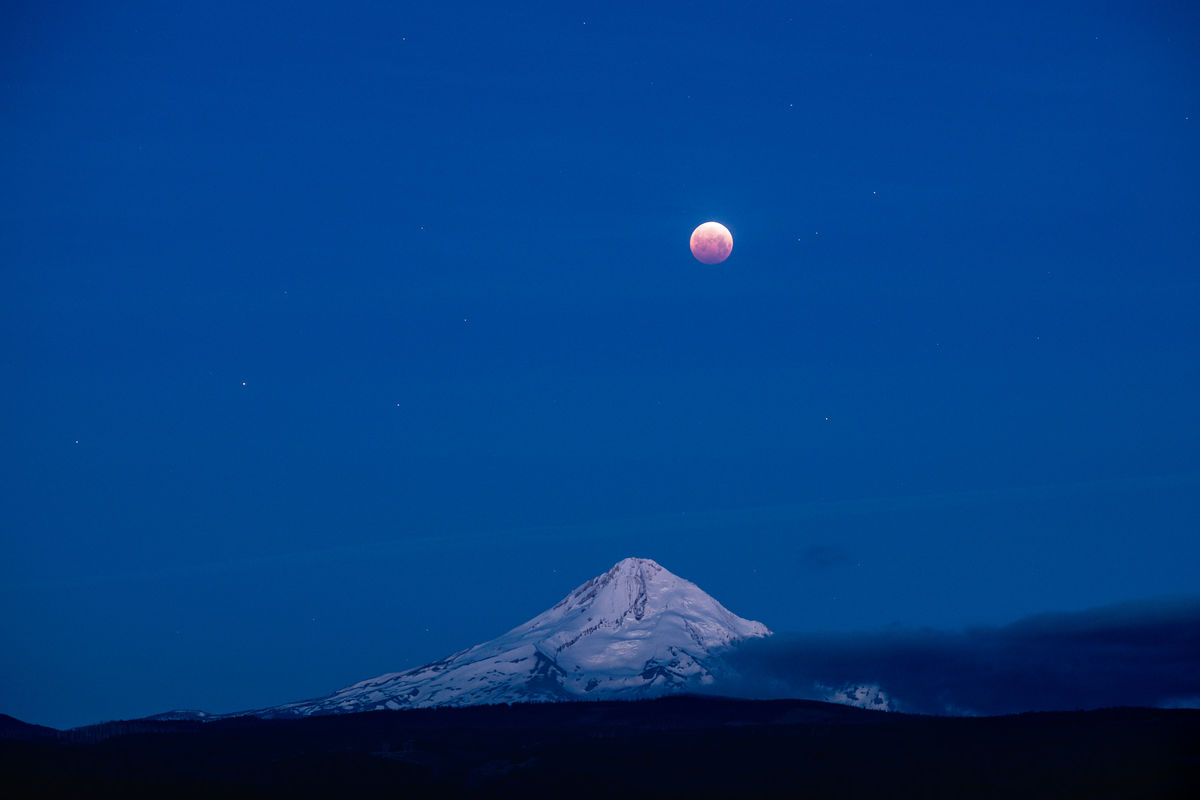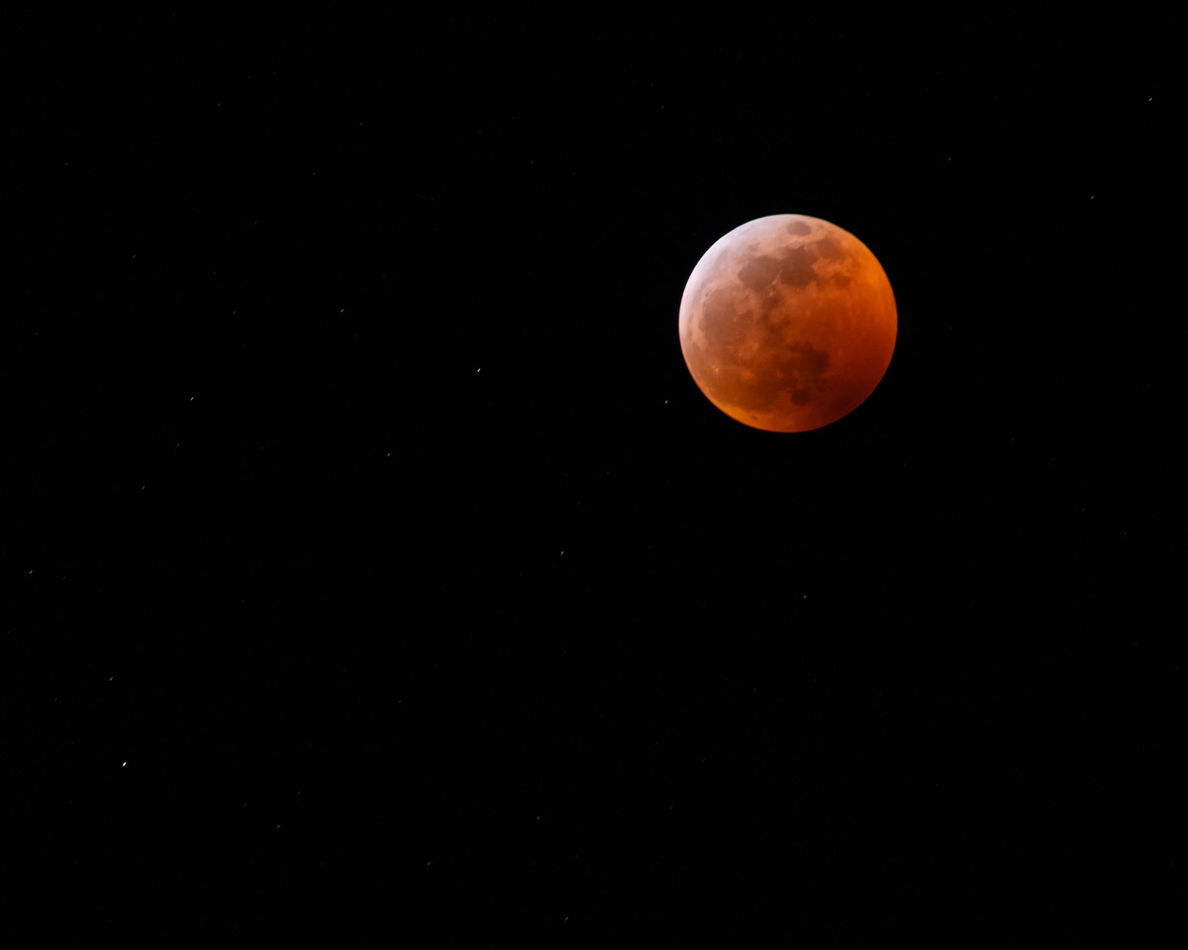Help with camera lenses and setting for May 15 lunar eclipse.
May 2, 2022 08:50:44 #
h0grider
Loc: Western MD
Judy795 wrote:
I just saw I am in a direct path of the lunar eclipse. The path looks like it will take it south of our local pier...
Deleted
May 2, 2022 10:34:07 #
January 2021
Super Blood Wolf Moon Total eclipse
Canon 6D MK II. EF
Taken in raw format
100-400 L at 400mm
ISO 1600. 2 seconds. f8. White balance 5100k
Live view remotely controlled and adjusted with iPhone paired to camera
Manual focus and sturdy tripod.
Camera set outside 3 hrs before to acclimate to 25 degrees f
If you do Double download you will see I made a mistake or two here with these settings. It was my first attempt. The key mistake was using a 2 second exposure which yielded slight star trails and a slightly blurred moon. I subsequently learned I should have used a one second max exposure at least at 400mm.
You live and learn.
BTW this is a low resolution photograph sized for social media
Super Blood Wolf Moon Total eclipse
Canon 6D MK II. EF
Taken in raw format
100-400 L at 400mm
ISO 1600. 2 seconds. f8. White balance 5100k
Live view remotely controlled and adjusted with iPhone paired to camera
Manual focus and sturdy tripod.
Camera set outside 3 hrs before to acclimate to 25 degrees f
If you do Double download you will see I made a mistake or two here with these settings. It was my first attempt. The key mistake was using a 2 second exposure which yielded slight star trails and a slightly blurred moon. I subsequently learned I should have used a one second max exposure at least at 400mm.
You live and learn.
BTW this is a low resolution photograph sized for social media
May 2, 2022 18:00:54 #
Orphoto
Loc: Oregon
Judy here an example from a year ago of finding a way to get the eclipsed moon somewhat near a selected subject. In this case the moon was getting close to setting as advancing morning light preceded the dawn.
135mm lens, f3.5, 2 secs, iso 800
135mm lens, f3.5, 2 secs, iso 800

May 2, 2022 19:57:49 #
Orphoto wrote:
Judy here an example from a year ago of finding a way to get the eclipsed moon somewhat near a selected subject. In this case the moon was getting close to setting as advancing morning light preceded the dawn.
135mm lens, f3.5, 2 secs, iso 800
135mm lens, f3.5, 2 secs, iso 800
That is very useful information. So a starting point with a 500mm on a ff might be 1 sec f8 at ISO 3200 (or 1/2 sec @ f5.6)
May 2, 2022 20:03:33 #
you will want to shoot between 1/150 and 1/250 of a sec. long exposure will show the moon moving and as it gets darker you will be changing settings so Its tough to tell you where to start. im sure the astronomy guys willknow a lot more.
May 2, 2022 20:10:07 #
Orphoto
Loc: Oregon
I shot using 2 cameras, both full frame. The other was busy with a 5oomm lens, but on a tracker. On that one I was using exposures of 5 secs, f4, iso 250. So for a non tracked exposure, that would be 2/3 sec, f4 about 1600 iso.
May 2, 2022 20:12:01 #
Sidwalkastronomy
Loc: New Jersey Shore
I would HEAVILY bracket
Few f stops in either direction. The total phase on lunar eclipse last a long time unlike a solar eclipse
Pick a ISO your comfortable with and bracket. You can use single point or small group to get gocus directly on moon. Remember if you use single point don't hit the Mara (dark spots, seas) use the other parts of moon. You should bracket few stops either direction.
Few f stops in either direction. The total phase on lunar eclipse last a long time unlike a solar eclipse
Pick a ISO your comfortable with and bracket. You can use single point or small group to get gocus directly on moon. Remember if you use single point don't hit the Mara (dark spots, seas) use the other parts of moon. You should bracket few stops either direction.
May 2, 2022 20:15:48 #
Orphoto
Loc: Oregon
bdk wrote:
you will want to shoot between 1/150 and 1/250 of a sec. long exposure will show the moon moving and as it gets darker you will be changing settings so Its tough to tell you where to start. im sure the astronomy guys willknow a lot more.
a 1/2 sec exposure is sufficient to stop stars & the moon from apparent movement with a 500 mm lense. Using a high resolution of a D850 i've adopted the "300 rule"
May 2, 2022 20:17:29 #
Orphoto
Loc: Oregon
I disagree with sidewalk. Don't autofocus on the moon. My preference is live view focussing on brighter stars.
May 2, 2022 20:25:11 #
Sidwalkastronomy
Loc: New Jersey Shore
Orphoto wrote:
I disagree with sidewalk. Don't autofocus on the moon. My preference is live view focussing on brighter stars.
If you have stars in the field that's a good option. My Tamron lens on auto exposure you can manually override auto focus without switching to manual. This is a perfect time to use BBF so you don't have to refocus between exposures. I use live view and on my Canon T7i and use the 5x 10x to focus BUT I would go to the limb so you have an edge to help you.
May 2, 2022 20:36:30 #
larryepage
Loc: North Texas area
Sidwalkastronomy wrote:
If you have stars in the field that's a good option. My Tamron lens on auto exposure you can manually override auto focus without switching to manual. This is a perfect time to use BBF so you don't have to refocus between exposures. I use live view and on my Canon T7i and use the 5x 10x to focus BUT I would go to the limb so you have an edge to help you.
I've reliably autofocused on the limb of the full moon with the Nikkor 200-500 f/5.6 but that's not likely to work on the eclipsed moon, which is much less bright. Best to autofocus on the bright moon, then shift to manual focus (or, as suggested, use BBF) and leave focus alone.
Final exposure selection can be quite subjective, depending on what tou want your moon to look like.
May 2, 2022 21:36:05 #
Sidwalkastronomy
Loc: New Jersey Shore
Lunar eclipses vary greatly. I remember on in the middle of large forest fires for weeks and that one was dark.
If it's a mirror camera lock mirror up and use remote exposure clicker. Tripod, of course.
If it's a mirror camera lock mirror up and use remote exposure clicker. Tripod, of course.
May 2, 2022 22:08:31 #
Sidwalkastronomy wrote:
Lunar eclipses vary greatly. I remember on in the middle of large forest fires for weeks and that one was dark.
If it's a mirror camera lock mirror up and use remote exposure clicker. Tripod, of course.
If it's a mirror camera lock mirror up and use remote exposure clicker. Tripod, of course.
I saw one in the 80's where the moon literally all but vanished. Totality was long so moon was probably dead centered in earth's shadow. On the other end, was one maybe 6 yrs ago where totality was 1 min and ended as the sun rose. While it was total theoritical, a small spot was lite and moved around. I figured due to refraction of the sun coming up vitually as the moon sat. As you said, they vary greatly.
May 2, 2022 23:01:05 #
TriX wrote:
That is very useful information. So a starting point with a 500mm on a ff might be 1 sec f8 at ISO 3200 (or 1/2 sec @ f5.6)
Yea my experience says that’s a good starting point for a total eclipse. Over 1 second with a 400 or 500 mm may yield star trails and a slightly blurred moon.
I know 2 seconds does. This effect reduces with decreasing focal length
May 2, 2022 23:06:47 #
bdk wrote:
you will want to shoot between 1/150 and 1/250 of a sec. long exposure will show the moon moving and as it gets darker you will be changing settings so Its tough to tell you where to start. im sure the astronomy guys willknow a lot more.
At 1/250 and f5.6 you would be shooting at roughly ISO 6400 to 12800 or more during a total eclipse
If you want to reply, then register here. Registration is free and your account is created instantly, so you can post right away.



